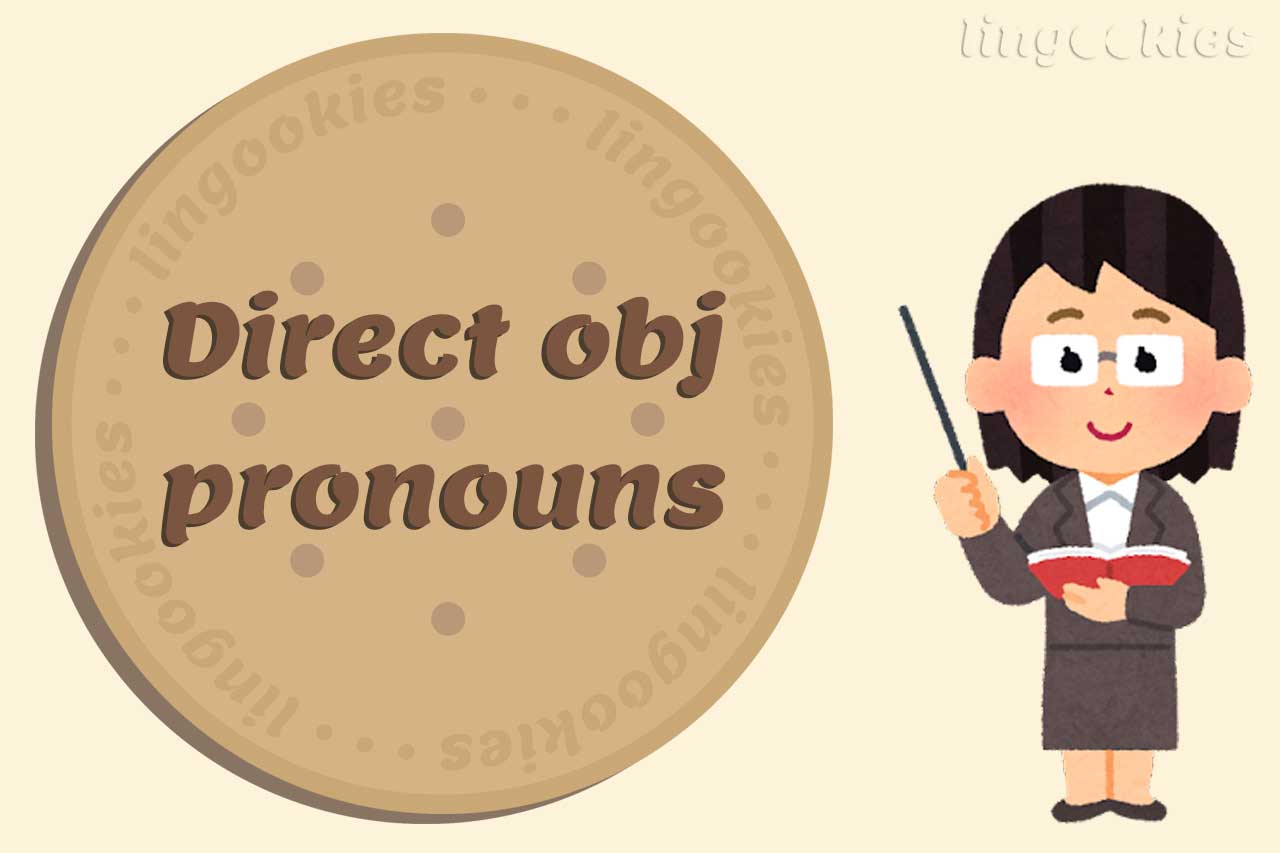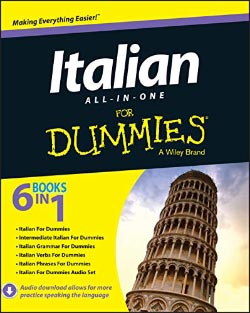What are the Italian direct object pronouns, and how do they work?
A pronoun is a part of speech that replaces a name or a person so you can avoid repeating them directly in the sentence. This is why they are called pronomi in Italian, from the Latin pro, “in place of”, and nomen, “name”.
Vedi quella nuvola? La vedi?
Can you see that cloud? Can you see it?
Mi piace il cioccolato. Lo mangio spesso.
I like chocolate. I eat it often.

There are many kinds of pronouns in Italian. In this lesson, we’ll take a look at the Italian direct object pronouns. How do they work? Let’s find out! Iniziamo!
Table of Contents
Italian direct object pronouns
As their name says, Italian direct object pronouns replace a direct object.
What’s a direct object? It’s the person or thing that “receives” the action expressed by the verb. For example:
Luca rompe la finestra.
Luca breaks the window.
Finestra is the direct object here. It’s the thing that is being broken by the kid. If we want to replace finestra with a pronoun, we will need to use one of the Italian direct object pronouns.
Luca la rompe.
Luca breaks it.
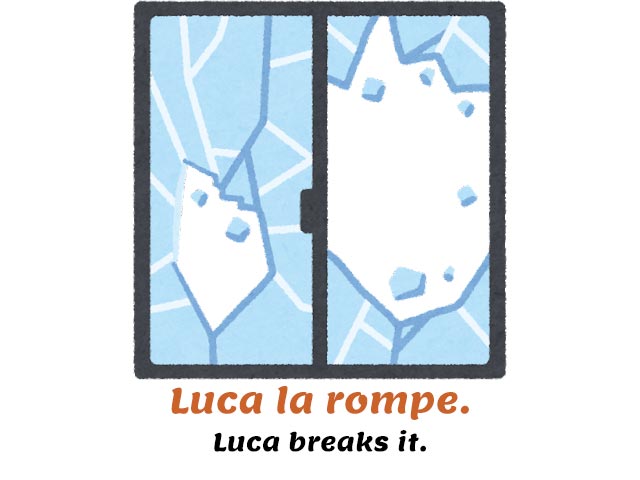
La replaces finestra and is a pronoun, just like the English word “it”. Don’t confuse this for the feminine definite article la!
Now consider the sentence…
Luca dà un regalo a sua mamma.
Luca gives her mom a gift.
Be careful here, as I see many learners make this mistake because of how the syntax works in English. There’s only one direct object here and it’s “gift”, not “mom”.
This is because “mom” is an indirect object. It could also be rendered in the sentence as Luca gives a gift to her mom. Italian is stricter and indirect objects are preceded by the preposition “to” (a sua mamma).
Luca lo dà a sua mamma.
Luca gives it to her mom.
Lo replaces un regalo, “a gift”.

How can you distinguish between direct objects and indirect objects in English?
Rephrase the sentence.
If one of the objects can be preceded by the preposition “to”, then it’s most likely that that object is an indirect object. If it cannot be preceded by the preposition “to”, then it’s most likely that that object is a direct object.
Here’s a handy table where you can see all the Italian direct object pronouns:
| Pronoun | English |
|---|---|
| Mi | Me, myself |
| Ti | You, yourself (sing.) |
| Lo, la | It (m/f) |
| Ci | Us, ourselves |
| Vi | You, yourself (pl.) |
| Li, le | Them (m/f) |
Title: Italian All-in-One For Dummies
Language: English / Italian
Publisher: For Dummies
Pages: 672
Learn to speak Italian like a native? Easy.
Italian All-in-One For Dummies appeals to those readers looking for a comprehensive, all-encompassing guide to mastering the Italian language. It contains content from all For Dummies Italian language instruction titles, including Italian For Dummies, Intermediate Italian For Dummies, Italian Verbs For Dummies, Italian Phrases For Dummies, Italian Grammar For Dummies, and Italian For Dummies Audio Set.
Where do I place the Italian direct object pronouns?
You may have already noticed that there’s a big difference between Italian and English when it comes to object pronouns.
Sento il fischio del vento. Lo sento bene.
I hear the whistle of the wind. I hear it well.
Why isn’t it “sento lo bene”? It’s because…
Italian direct object pronouns are placed BEFORE any normal verb and auxiliary verb. This is a BIG difference from English, where they directly take the place of the thing/person they replace.
When Italian direct object pronouns are placed before the verb, they are said to be in their forma atona (“unstressed form”).
Hai preso i biglietti? – Sì, li ho presi.
Did you get the tickets? – Yes, I took them.
Hai pulito camera tua? – No, non l’ho pulita.
Did you clean your room? – No, I didn’t clean it.
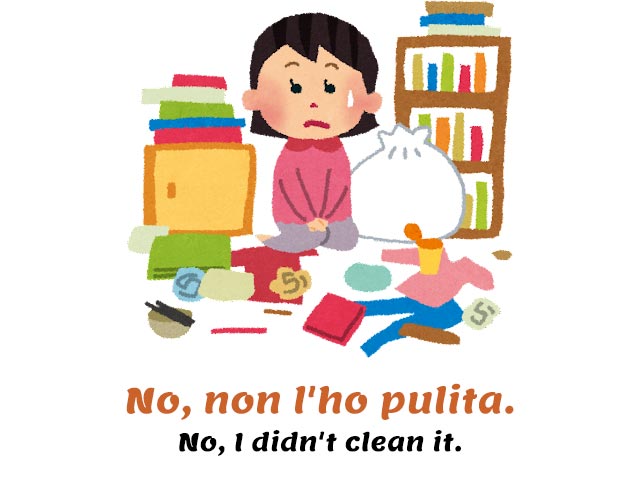
L’ is the abbreviated form of either lo or la. Notice that in compound tenses like the passato prossimo, Italian direct object pronouns are placed before the auxiliary verb, not the main verb.
You NEVER shorten li and le to l’.
Also, be aware that the past participle needs to match the direct object pronoun in number and gender.
Hai pulito camera tua? – No, non l’ho pulita.
Did you clean your room? – No, I didn’t clean it.
(Camera is a feminine singular noun.)
Hai chiuso le finestre? – No, non le ho chiuse.
Did you close the windows? – No, I didn’t close them.
(Finestre is a feminine plural noun.)
Hai innaffiato i fiori? – Sì, li ho innaffiati.
Did you water the flowers? – Yes, I watered them.
(Fiori is a masculine plural noun.)
Watch out for modal verbs
We’ve just said that Italian direct object pronouns are to be placed before the verb. With three exceptions.
First exception. There are 4 modal verbs in Italian: volere, dovere, potere and sapere. Modal verbs are the only verbs that can be directly followed by an infinitive verb.
Devo pulire camera mia.
I have to clean my room.
Voglio leggere questo libro.
I want to read this book.
Pulire and leggere are infinitive verbs (the form you will find in dictionaries). When a modal verb is present, you can choose where to place the Italian direct object pronouns.
The pronouns can either go before the modal verb itself:
La devo pulire.
I have to clean it.
Lo voglio leggere.
I want to read it.

Or they can go after the infinitive verb. In this case, the pronoun won’t stand as a word of its own but it will be appended to the infinitive verb by dropping the final -e of the verb.
Devo pulirla.
I have to clean it.
(Pulir + la)
Voglio leggerlo.
I want to read it.
(Legger + lo)
Both orders are commonly used and interchangeable. It’s just a matter of taste, so don’t think too much about it.
Watch out for infinitive verbs
Second exception. You will often find infinitive verbs that are preceded by prepositions in Italian. This happens because a number of Italian verbs, such as iniziare, need to be followed by a preposition before other verbs (iniziare a, finire di, continuare a…).
Paolo inizia a leggere il libro.
Paolo starts to read the book.
A roughly translates “to” in English. We’ve said it’s followed by an infinitive verb, in this case leggere, “to read”.
If you want to replace il libro with a pronoun, you can either place the direct pronoun before the main verb iniziare…
Paolo lo inizia a leggere.
Paolo starts to read it.
Or you can yet again append it to the infinitive verb by dropping its final -e.
Paolo inizia a leggerlo.
Paolo starts to read it.
(Legger + lo)
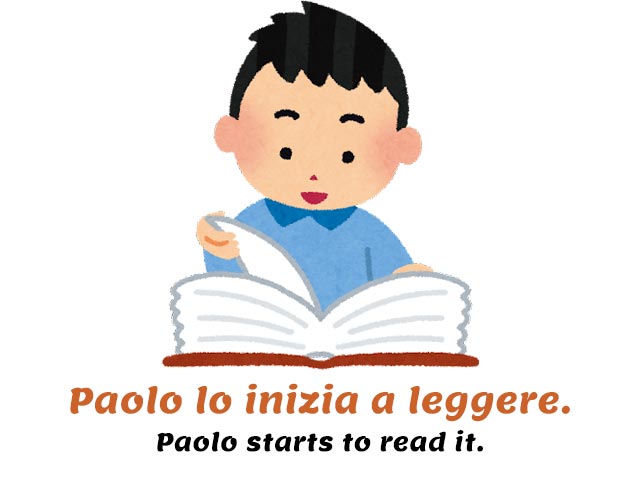
Other examples:
Dario inizia a fare i compiti. Dario inizia a farli.
Dario starts to do his homework. Dario starts doing it.
Sara finisce di pulire la cucina. Sara finisce di pulirla.
Sara finishes cleaning the kitchen. Sara finishes cleaning it.
Watch out for imperative verbs
Third exception. The imperative mood is used to give out orders.
Chiudi la porta!
Close the door!
Fermi quel ladro!
Stop that thief!
When you want to replace a direct object that is tied to an imperative verb, you will have to take into account the formality of the request and the type of imperative (positive, negative).
For informal requests (informal imperative mood), the pronoun will have to be appended to the imperative verb.
For formal requests (formal imperative mood), the pronoun will have to be placed before the imperative verb.
Chiudi la porta! Chiudila!
Close the door! Close it!
(Informal)
Chiuda la porta, per favore! La chiuda!
Please close the door! Close it!
(Formal)

In the negative form, the Italian direct object pronouns can either be appended to the verb or be placed before it, it makes no difference.
Non mangiarlo! Non lo mangiare!
Don’t eat it!
Non toccarlo! Non lo toccare!
Don’t touch it!
Stressed Italian direct object pronouns
In their stressed form, Italian direct object pronouns are said to be in their forma tonica. These are used to really stress the pronoun and always come AFTER the verb.
| Stressed pronoun | English |
|---|---|
| Me | Me, myself |
| Te | You, yourself (sing.) |
| Lui, lei | It (m/f) |
| Noi | Us, ourselves |
| Voi | You, yourself (pl.) |
| Loro | Them (m/f) |
Let’s see a few examples of unstressed and stressed direct object pronouns in Italian:
Io ti amo. Io amo te e nessun altro.
I love you. I love you and nobody else.
Puoi ascoltarmi, per favore? Ascolta me, non ascoltare lui!
Can you please listen to me? Listen to me, don’t listen to him!
Marta non vuole me. Vuole te!
Marta doesn’t want me. She wants you!
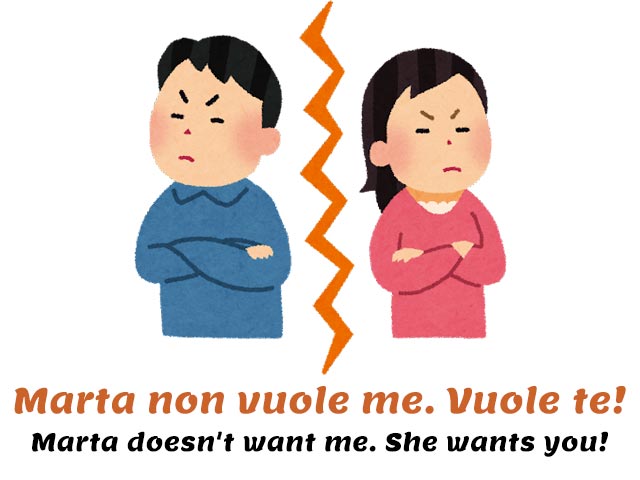
Hopefully, you have a clearer picture of how the Italian direct pronouns work now! Now let’s see how the unstressed Italian direct object pronouns work for all subject pronouns.
Mi
This translates into the direct English pronoun “me”.
Mi vedi?
Do you see me?
Perché mi ringrazi?
Why are you thanking me?
Ti
This translates into the direct English pronoun “you” in the singular.
Ti vedo.
I see you.
Ti posso prendere per mano?
Can I hold you by your hand?

Lo, la
Lo translates into the direct English pronoun “it” for masculine nouns in the singular, while la translates into the direct English pronoun “it” for feminine nouns in the singular.
Vedo il treno. Lo vedo.
I see the train. I see it.
Vedo la casa. La vedo.
I see the house. I see it.
Ci
This translates into the direct English pronoun “us” or “ourselves”.
Ci vedi?
Do you see us?
Ci puoi avvisare quando arrivi a casa?
Can you let us know (warn) when you get home?
Vi
This translates into the direct English pronoun “you” in the plural.
Vi vedo.
I see you.
Vi avviserò quando ho finito.
I will notify you when I am finished.
Li
Li translates into the direct English pronoun “them” for masculine nouns in the plural, while le translates the direct English pronoun “them” for feminine nouns in the plural.
Vedo gli alberi. Li vedo.
I see the trees. I see them.
Vedo le finestre. Le vedo.
I see the windows. I see them.
And that’s it with the Italian direct object pronouns! If you still have any doubts, feel free to leave a comment.
What next?
Now that you’ve seen how the Italian direct object pronouns work, you might want to keep learning Italian online with these free Italian resources:
Or you might also want an excellent offline Italian grammar resource to take with you at all times (Amazon).
❤️ If you liked this guide on the Italian direct object pronouns, consider sharing it with your social media friends who are also studying Italian.

